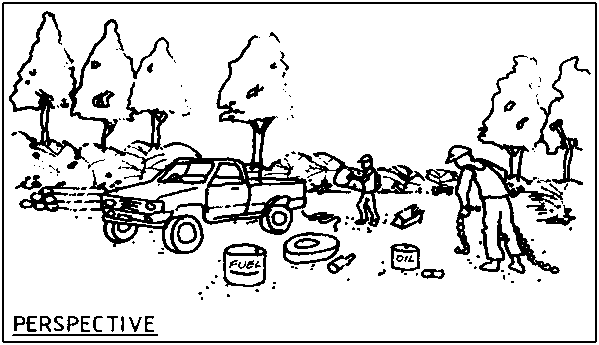9.1 Moving Equipment
9.2 Workshop Facilities
9.3 Toxic Waste
9.4 Main Fuel and Oil Storage
9.5 Field Servicing and Maintenance
9.6 Refuse Disposal
|
OBJECTIVES To ensure machinery is in sound and safe working condition. To prevent pollution of water resources. To avoid introducing non-endemic species and pathogens to new areas. To maintain a clean and tidy harvesting operation. |
 All equipment should
be washed thoroughly before it is moved to a new operation area to prevent the
spread of weeds, pests and disease.
All equipment should
be washed thoroughly before it is moved to a new operation area to prevent the
spread of weeds, pests and disease.
 Care must be taken
to avoid spillage of fuel or oil during transportation.
Care must be taken
to avoid spillage of fuel or oil during transportation.
 Locate facilities at
least 50 m from any water body or watercourse.
Locate facilities at
least 50 m from any water body or watercourse.
 Drainage from
workshop areas should be diverted into collecting/settling ponds.
Drainage from
workshop areas should be diverted into collecting/settling ponds.
 Non-toxic solid
waste should be removed or buried and covered with at least 0.5 m of
soil.
Non-toxic solid
waste should be removed or buried and covered with at least 0.5 m of
soil.
 The use of toxic
substances is to be minimised and wherever possible biodegradable substitutes
used.
The use of toxic
substances is to be minimised and wherever possible biodegradable substitutes
used.
 Toxic materials
include spent hydraulic and refrigeration fluid, oil, fuel (petrol, diesel),
workshop wastes, oily water separator sludge and residues, industrial cleaners,
paints and resins, preservatives (including timber treatment chemicals),
distillates, lubricants, insecticides, and biocides.
Toxic materials
include spent hydraulic and refrigeration fluid, oil, fuel (petrol, diesel),
workshop wastes, oily water separator sludge and residues, industrial cleaners,
paints and resins, preservatives (including timber treatment chemicals),
distillates, lubricants, insecticides, and biocides.
 Toxic materials are
to be collected in containers securely sealed and preferably returned to
municipal/township disposal areas, returned to the manufacturer or buried in an
appropriate waste pit.
Toxic materials are
to be collected in containers securely sealed and preferably returned to
municipal/township disposal areas, returned to the manufacturer or buried in an
appropriate waste pit.
 Where onsite burial
of toxic materials and their containers is the only alternative, the location of
the pit should be clearly indicated (including signs in all the local
languages), and the pit securely fenced.
Where onsite burial
of toxic materials and their containers is the only alternative, the location of
the pit should be clearly indicated (including signs in all the local
languages), and the pit securely fenced.
 All waste pits are
to be covered with at least 0.5 m of soil and located at least 100 m from
maximum inundation by water and at least 1 m above maximum groundwater
height.
All waste pits are
to be covered with at least 0.5 m of soil and located at least 100 m from
maximum inundation by water and at least 1 m above maximum groundwater
height.
 Locate main fuel and
oil storage:
Locate main fuel and
oil storage:
- in a well drained area at least 50 m from any watercourse; and
- no closer than 100 m to village areas.
 Bunds (preferably
concrete mounds) with a capacity of twice (× 2) the storage capacity must
be provided around the storage.
Bunds (preferably
concrete mounds) with a capacity of twice (× 2) the storage capacity must
be provided around the storage. Drains are to be
directed to a closed, stable and flood free disposal pit, at least 50 m from a
watercourse or water body.
Drains are to be
directed to a closed, stable and flood free disposal pit, at least 50 m from a
watercourse or water body.
 Where main fuel
storage facilities must be located on a wharf, they should be:
Where main fuel
storage facilities must be located on a wharf, they should be:
- located as far away from the sea as the fuel pumping lines permit;- surrounded by a leak-proof bund, which in the event of a spill can contain all fuel so that it can later be pumped to a disposal pit at least 50 m from a water body.
 Field fuel tanks,
refuelling points and maintenance areas are to be located:
Field fuel tanks,
refuelling points and maintenance areas are to be located:
- in well-drained areas, such as landings or road junctions;
- outside areas excluded from harvesting;
- more than 50 m from a watercourse.
 Care must be taken
to prevent spillage during refuelling.
Care must be taken
to prevent spillage during refuelling. Sump oil should not
be dumped in the harvesting areas. It should be collected and removed to the
main disposal facility.
Sump oil should not
be dumped in the harvesting areas. It should be collected and removed to the
main disposal facility.
All solid waste should be placed in a refuse pit and buried as soon as harvesting in the coupe is completed.
Figure 9-1: Removal of all Refuse from Harvesting Areas
